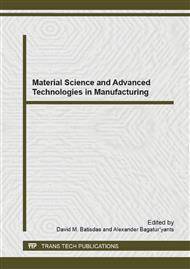p.147
p.153
p.157
p.163
p.168
p.173
p.178
p.183
p.188
The Residual Stress after High Frequency Induction Welding with Complex Shapes WC-Co Alloy and Steel
Abstract:
Residual stresses were investigation by Three-D finite element simulation and experimental method. The Three-D finite element simulation confirms large residual stress appears in seam zone because of the crack part and the maximum loading parts were not coinciding. The heating/cooling rate can seriously affect the residual stress. Along with the heating rate decrease, the residual stress reduces in material and had big drop in high heating rate range than lower range. And cooling rate influence the residual stress in cemented carbide was more sensitive than in steel. Meanwhile, far away the seam, the residual stress decrease and became stable. After heat treatment, the residual stress reduced from more than 800MPa, 300MPa to less 100MPa, 52Mpa in WC-Co side and steel side respectively and the material had better abrasion resistance and high strength.
Info:
Periodical:
Pages:
168-172
Citation:
Online since:
January 2014
Price:
Сopyright:
© 2014 Trans Tech Publications Ltd. All Rights Reserved
Share:
Citation:


